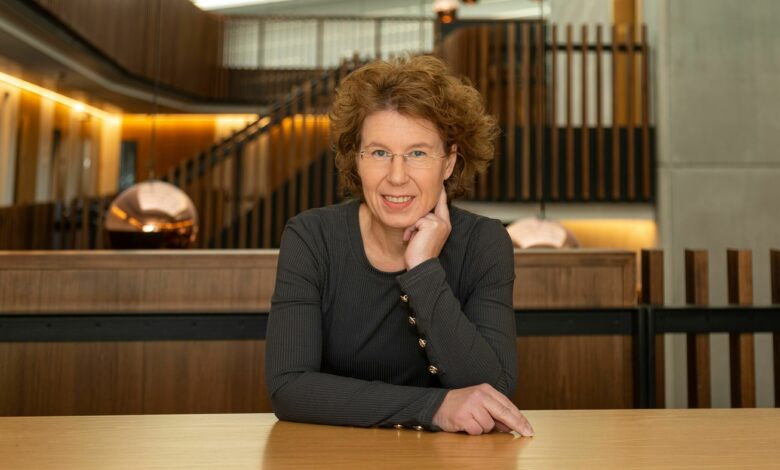She became a YouTube star. Now it helps fund her physics research : NPR


Theoretical physicist and YouTuber Sabine Hossenfelder, shown in a photo taken in December at the University of Oxford in England, turned to YouTube “to keep my sanity” during the dark days of the pandemic.
Anthony Sajdler
hide caption
toggle caption
Anthony Sajdler

Theoretical physicist and YouTuber Sabine Hossenfelder, shown in a photo taken in December at the University of Oxford in England, turned to YouTube “to keep my sanity” during the dark days of the pandemic.
Anthony Sajdler
The dark days of the COVID-19 pandemic helped transform Sabine Hossenfelder into an unlikely social media star. In the process, she has raised a few eyebrows among her fellow scientists. She’s also made an important discovery that just might bode well for her future research.
Hossenfelder turned to YouTube “to keep my sanity” when she was unable to go to her office at Germany’s Frankfurt Institute for Advanced Studies. Actually, you might say she returned. She’d started a channel in 2007 but just hadn’t been very active. Then came a rebranding — Science without the gobbledygook. Today, she has 1 million subscribers (up from 50,000) and also enjoys a strong and growing contingent of Patreon supporters.
Several times a month, the theoretical physicist and mathematician drops a new video, dispensing her dry wit and pithy wisdom to a loyal fan base of nerds across the internet.
She takes her role as a science communicator seriously, aiming her videos at an audience seeking context. “People can go to my channel and get the brief, 20-minute summary,” Hossenfelder says. “They don’t have to read a whole book or download a review article, which they won’t understand anyway.”
Have you heard the one about the scientist who’s got jokes?
Her channel stakes out the no-man’s land between gee-whiz science and the heavyweight journals. From her experience as a freelance writer, Hossenfelder says she “knew full-well that there were stories you just can’t get by an editor, not because they’re wrong, but because they have no timely hook.” She aims to fill that gap.
It all comes packaged with a spoonful of humor to help the science go down:
Are we all living in a computer simulation? “I quite like the idea … it gives me hope that things will be better on the next level,” she says.
Why does 5G technology use high frequencies? “There’s a reason they haven’t been previously used for telecommunication, and it’s not because millimeter waves are also used as goodbyes for in-laws.”
As her YouTube channel has gained traction, Hossenfelder has been able to hire a handful of writers, though she still writes most of her own jokes. She’s no longer at the Frankfurt Institute but has a research position at the Munich Center for Mathematical Philosophy. Meanwhile, her dive into social media has allowed her to largely escape the perpetual pursuit of research grants that she says is “always kind of like a lottery.”
Posting videos to the internet, it turns out, generates a more reliable revenue stream to fund her work in quantum gravity. YouTube provides some money directly, but Hossenfelder gets more through sponsors who advertise on her channel, Patreon supporters and donations. Crunching the numbers, she “realized that so long as I would keep producing interesting content, I would have an income.”
She hears the critics and has frank answers for them
Hossenfelder’s science channel has also become a ready platform for her somewhat contrarian views on the state of physics. Among them is what she sees as the problem of beauty, the pursuit of simplicity. Specifically, how her colleagues who try to fathom the fundamental underpinnings of the universe are obsessed with it.
As far back as the Renaissance, scientists have sought compact and elegant descriptions of space, time and motion: a sort of scientific version of Occam’s razor — that the simplest explanation tends to be the correct one. But as we seek answers in a complex universe, Hossenfelder cautions that the quest for simplicity could be a dead end. Her 2018 book on the topic, Lost in Math: How Beauty Leads Physics Astray, served as something of a shot across the bow of modern physics.
Fellow physicists, she contends, “have come up with very narrow notions of beauty, which they derived from things that worked in the past.”
“It’s all well and fine. It’s worth a try,” she says. “But now they’ve gotten stuck on it. This is why you see so many ideas that fail over and over again.”
Sabine Hossenfelder via
YouTube
In her mind, one such failure has been the effort to explain dark matter, the so-far undetected and unexplained something that makes up a large percentage of the universe. “At the point where we are now, it’s pretty clear that it can’t be a simple story. It’s got to be something more complicated than some kind of new particle,” she says.
To be sure, Hossenfelder, 47, isn’t the only physicist wondering aloud how far the standard model of particle physics can be pushed in the service of dark matter. She describes herself as “pretty much a voice in the wilderness,” but some others, such as astrophysicist Pavel Kroupa, have publicly expressed similar skepticism.
Patricia Rankin, who chairs the department of physics at Arizona State University, says that while she doesn’t entirely agree with Hossenfelder’s views on physics, “I’m definitely in sympathy with a lot of what she says about it being important to actually delineate what science can and can’t tell us.” She praises Hossenfelder for “[challenging] people’s assumptions … because that’s really what science is all about.”
Stacy McGaugh, a professor of astronomy at Case Western Reserve University, met Hossenfelder at a conference several years ago, where they were both on the roster of speakers. They discovered a shared view on many issues, including that the gaping hole in physics left by dark matter might be at least partially filled by a modified theory of gravity. The two have since collaborated on multiple scientific papers. “She’s very frank and plainspoken and is not afraid to speak her mind. And that’s great,” McGaugh says.
That frankness has placed her at odds with some big guns of science, including Don Lincoln, a physicist and researcher at the Fermi National Accelerator Laboratory (Fermilab) outside of Chicago. Unlike Hossenfelder, his work is focused on the experimental side of cutting-edge physics. Lincoln, a fixture on Fermilab’s YouTube channel, co-discovered the top quark in 1995 and was part of the team in 2012 that discovered the Higgs boson at Europe’s Large Hadron Collider. He and Hossenfelder have occasionally sparred online, he says.
“It’s not like we are mortal enemies or anything like that,” he’s careful to point out. But in a recent episode of Science without the gobbledygook, Hossenfelder took experimental scientists to task for their pursuit of ever-larger, more-powerful and expensive colliders that she believes have little prospect of making important new discoveries.
Lincoln, however, says there are good reasons to believe that dark matter will turn out to be previously unseen particles and not some modified form of gravity. “Most cosmologists would say that while it’s true that these modified motion and modified gravity theories can be made to work pretty well on the size of rotating galaxies, or the size of clusters of galaxies, where they fail is on the truly cosmic scale,” he says.
Sabine Hossenfelder via
YouTube
Hossenfelder has also staked out a number of contentious and not-so-contentious positions through her writings and more than 300 YouTube videos:
Artificial intelligence? “It’s going to make a lot of things much more consumer friendly. And mostly I think it’s a good thing.”
Climate change? “I don’t think it’s an existential threat. Not by itself, but it’s a threat multiplier.”
Hossenfelder also “totally believes” in extraterrestrial intelligence. “I would say abundant in the universe. But abundant in our galaxy? I don’t know.”
“If I had time, I would probably be on TikTok”
On a parallel track to her science channel, Hossenfelder has produced an eclectic mix of music videos, ranging from Beethoven’s Ode to Joy to a cover of “Galaxy Song” from the 1983 Monty Python film The Meaning of Life. She learned most of it at YouTube University. “I am mostly interested in audio mixing. I have a thing for quirky sound effects and synths and echoes and reverb and all kinds of distortions,” she says.
Juggling the roles of scientist and content creator with her personal life — she lives with her husband and has twin daughters in their early teens — can be a bit overwhelming, she acknowledges. Besides YouTube, she’s on Substack and also hosts a podcast. “If I had the time, I would probably be on TikTok, but at the moment I just can’t do it,” Hossenfelder says.
It’s more acceptable nowadays to be both a scientist and someone who explains science to the public, she says. Giants such as the late Carl Sagan — and, more recently, Neil deGrasse Tyson — have helped pave the way. But among her fellow scientists, “there’s still this line of thought that Sabine is not doing research anymore … that she’s now doing YouTube,” Hossenfelder says.
“Basically I don’t care. I do my thing,” she says.
McGaugh, Hossenfelder’s collaborator and co-author, expresses concern that her heavy commitment to social media might inevitably crowd out her research. “I can see the pressures,” he admits. “But Sabine so far has managed to do both.”
Arizona State’s Rankin says Hossenfelder’s efforts to fund her own research, while unusual today, hark back to an era when gentlemen scientists put up their own money to build scientific instruments, such as telescopes, and pay for scientific expeditions. “But then … it was like you just couldn’t afford to do science unless you were funded through a federal government,” Rankin says.
It remains to be seen whether others follow Hossenfelder’s lead. Regardless, she’s continuing to build her brand with plans to add quizzes to go with the YouTube videos that she hopes will “help with understanding the material.”
Last year, she published her second book, Existential Physics: A Scientist’s Guide to Life’s Biggest Questions. And she’s working on two new scientific papers.
While the gender divide in physics is marginally less stark in Germany than in America — by one estimate, a quarter of Ph.D.s in physics are women there, while it’s only about a fifth in the U.S. — Hossenfelder eschews the “role model” label.
“I’m a sarcastic, annoying, permanently grumpy middle-aged woman, and no one in their right mind should strive to be anything like me,” she says.






